2007 UPDATED RECOLLECTIONS OF THE 174TH AVN CO
DUC PHO 1967-68
Glen Gibson
And this is the absolute truth!…. There I was, leaning against Doc Schoolfield's jeep, discussing the previous night's mortar attack, when I looked down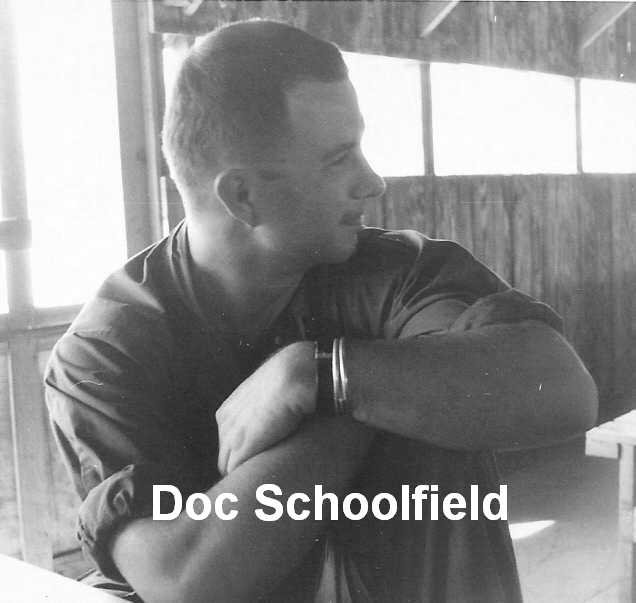 and saw a rather battered but yet unexploded 60 mm mortar round under the back seat. I gently took Doc by the arm and said, "Get your ass out of the jeep Doc, there's a live mortar round rolling around in back!" Now the Doc was usually a rather calm individual, but without additional persuasion, he un-assed the jeep and dove headfirst into the operations bunker! After EOD evacuated the round, we discovered that it had made a direct hit on the back seat of Doc's jeep. Apparently, the padding was enough to prevent an explosion, or else Charlie hadn't set the fuse correctly. In any case, Doc was somewhat shaken, as he had driven around all morning with the thing rattling around right behind him. I accused him of poor preflight and suggested he start using a checklist. I don't know where Doc Schoolfield is now, but he was a nice guy, and he and his medics were a real asset to the 174th during 1967-68. and saw a rather battered but yet unexploded 60 mm mortar round under the back seat. I gently took Doc by the arm and said, "Get your ass out of the jeep Doc, there's a live mortar round rolling around in back!" Now the Doc was usually a rather calm individual, but without additional persuasion, he un-assed the jeep and dove headfirst into the operations bunker! After EOD evacuated the round, we discovered that it had made a direct hit on the back seat of Doc's jeep. Apparently, the padding was enough to prevent an explosion, or else Charlie hadn't set the fuse correctly. In any case, Doc was somewhat shaken, as he had driven around all morning with the thing rattling around right behind him. I accused him of poor preflight and suggested he start using a checklist. I don't know where Doc Schoolfield is now, but he was a nice guy, and he and his medics were a real asset to the 174th during 1967-68.
I joined the 174th as a BFNG in September 1967. I remember the day well, standing on the ramp in front of the operations bunker in a steady drizzle with my B-4 bag in one hand and an unopened bottle of Johnny Walker Black in the other. Major Tom Wheat, the CO, appeared and welcomed me to Duc Pho. It was only later, that I learned that Tom was a teetotaler, anti-booze person. He never said a word as I placed the JW bottle atop the refrigerator in his hootch, and took over the bunk and job of XO. That bottle sat there until the day I rotated, and still was over half full. The heaviest pulls had been taken by a couple of Air Force C-123 pilots who were our unexpected overnight houseguests after they totally demolished their aircraft attempting a take-off from Duc Pho's PSP fixed wing strip.
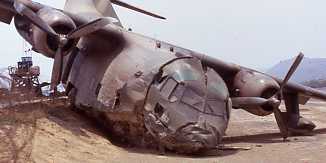
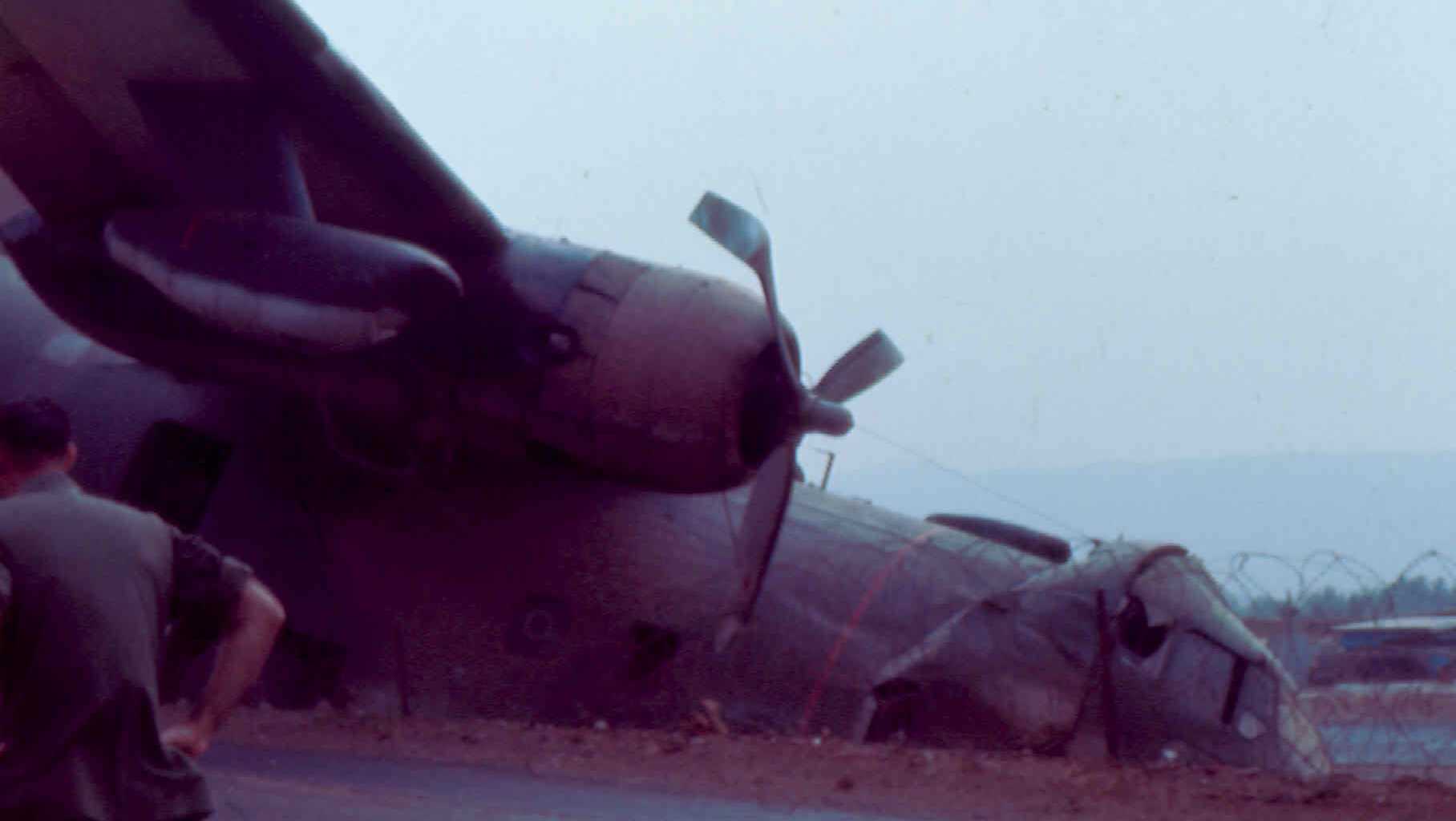
Tom Wheat rotated in January, 1968, and I was fortunate enough to be selected as his replacement. I served as CO until my rotation in September, 1968. 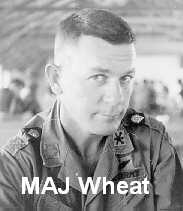 Tom's untimely death in a fixed wing accident in Colorado in 1969 was depressing, to say the least. His contributions to the history of the 174th while at Duc Pho, were many. Tom's untimely death in a fixed wing accident in Colorado in 1969 was depressing, to say the least. His contributions to the history of the 174th while at Duc Pho, were many. 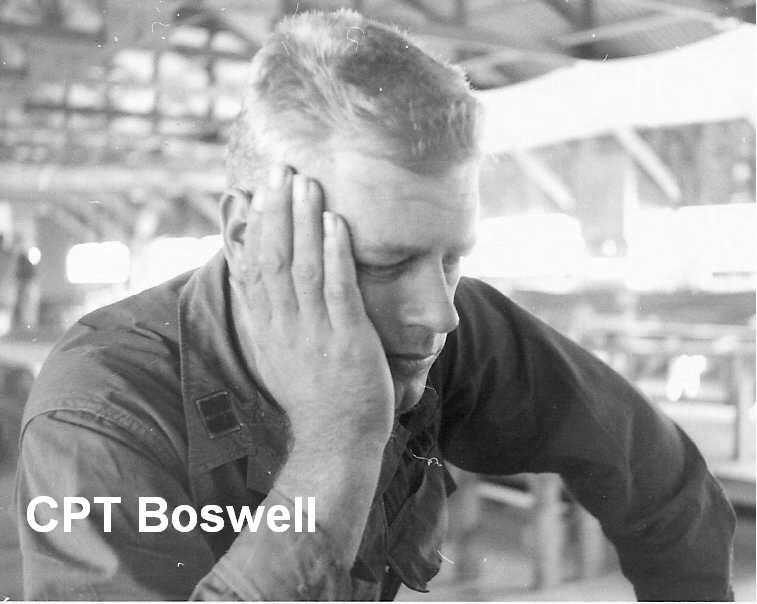 He was instrumental in getting the troops out of tents and into bunkered hootches. This action alone saved many casualties, as Charlie mortared or rocketed the company area at least once a week, whether we needed it or not. Some of Tom's other efforts were the construction of a grand mess hall we once crowded 600 troops into, to see the only USO show ever to appear at Duc Pho. Also, he caused workable field showers to be built, and generally made life a little safer and more comfortable for all the troops. Tom was a mover and a shaker and it showed in everything he did, including his flying. He enjoyed leading CA's and the hotter the LZ, the better! He deserved a longer life. He was instrumental in getting the troops out of tents and into bunkered hootches. This action alone saved many casualties, as Charlie mortared or rocketed the company area at least once a week, whether we needed it or not. Some of Tom's other efforts were the construction of a grand mess hall we once crowded 600 troops into, to see the only USO show ever to appear at Duc Pho. Also, he caused workable field showers to be built, and generally made life a little safer and more comfortable for all the troops. Tom was a mover and a shaker and it showed in everything he did, including his flying. He enjoyed leading CA's and the hotter the LZ, the better! He deserved a longer life.
Capt. George Boswell was my XO until Major Dick Zimmerman arrived in the summer of '68. George's talent was his ability to beg, borrow, or steal absolutely anything. As XO, his main duty was providing for troop morale. This mission, he accomplished well. Give him an aircraft for one day, and a good co-pilot to navigate (George had problems with navigation), and he would return loaded with goodies. His credits included commercial refrigerated beer coolers, popcorn machines, tons of pallets of beer, building materials, fresh vegetables, and even on one occasion, a huge Navy seaport lighthouse beacon still in the crate! He had lifted this out of the middle of a Navy supply depot, mistaking it for something more suitable. George was responsible for arranging for and coordinating the logistics for the USO show which appeared at Duc Pho.
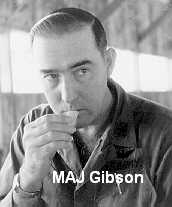 Major Dick Zimmerman was a gung-ho Armored officer who, like Wheat, enjoyed being right in the thick of a hot CA. Shortly after my departure, he was reassigned as CO of a Cav troop in the highlands and lost his life doing what he came to Vietnam to do, "Going after those bastards". Dick was a friendly and very capable officer whose early passing was a great loss and shame.
Major Dick Zimmerman was a gung-ho Armored officer who, like Wheat, enjoyed being right in the thick of a hot CA. Shortly after my departure, he was reassigned as CO of a Cav troop in the highlands and lost his life doing what he came to Vietnam to do, "Going after those bastards". Dick was a friendly and very capable officer whose early passing was a great loss and shame.
Major Dick Brown replaced me as CO in September 1968. While I only encountered him briefly at the change of command ceremony, he seemed to be a very capable and likeable individual. Later reports I received indicated he did an outstanding job as CO and was well liked by the troops. Major Brown was killed during a rocket attack on the company area in March 1969. The CO's hootch took a direct hit. Also killed, was the brand new XO, Capt. Rogers. This was the same hootch Tom Wheat and I helped complete, and occupied during our tours. During TET of '68, the hootch also took a direct hit by an 82 mm mortar. Damage was minimal and neither Boswell nor I was injured, but the blast caused hearing problems for me, which later proved to be serious. I really believe luck was a major factor in determining who survived, and who didn't, in Nam.
During 1967-68, the 174th was the leading Army Aviation unit in country in total hours flown, aircraft availability rate, and missions flown, month after month. It also had the lowest accident-to-hours flown ratio and casualties-to-hours flown ratio, within the 1st Aviation Brigade. When the 1st Aviation Brigade was designated as the outstanding Army Aviation Unit worldwide in 1967, Tom Wheat, as 174th CO, was chosen to accompany the brigade commander to the annual aviation convention in Washington DC to receive the honors.
The accomplishments of the 174th during that period are a tribute to everyone who was assigned to the unit and support detachments. It truly was a team effort. Pilots and crews were turning 180 hours in 20 days, resting for three (sometimes) and starting on the next 180. The 409th Maintenance Detachment, under the capable command of Capt. Grant Cayton, worked around the clock to keep aircraft availability high.
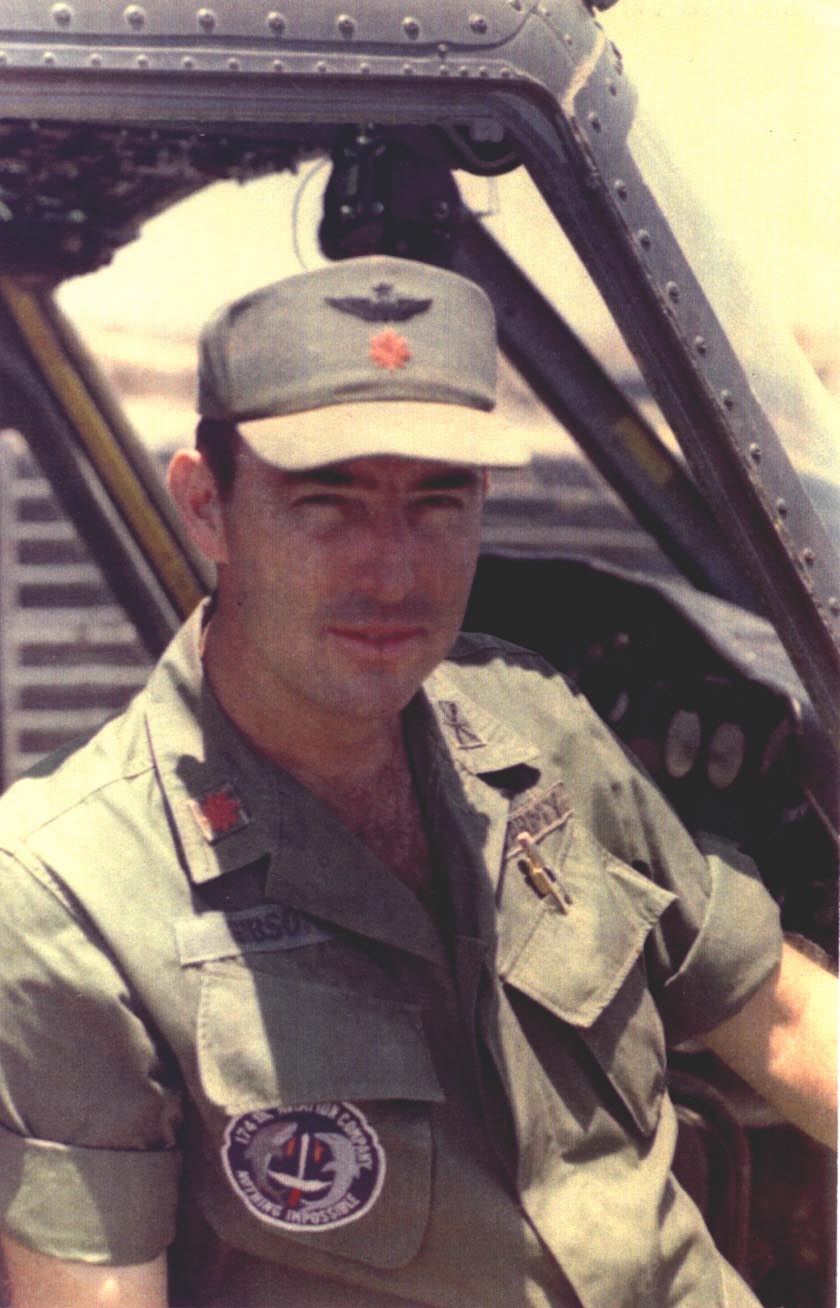
Capt. Cayton's unique and successful revolving program for time compliance inspections and scheduled maintenance, was acknowledged throughout the brigade. Many maintenance officers from other units dropped by to see how it worked, so they could implement a similar program in their units. However, the real truth can now be told….Capt. Cayton and crew's secret was spare parts availability. They kept a team in the air almost continuously looking for spare parts. What they couldn't requisition through the front door, they begged, bartered, or otherwise got through the back door. The rumor was, they once lifted an entire Huey out of a depot, leaving only the tail number behind, taped to a 55 gallon barrel. Even if not totally true, it was close. When other units were waiting weeks for engines, Capt. Cayton had a couple stashed ready to go. If my memory serves me correctly, they once changed a complete engine in a D model and test flew it, all in less than two hours. They never let a repair which normally would be accomplished only at field maintenance or depot level stop them. They did it all right there in the Nam sun, on the ramp at Duc Pho. A sad note, CWO Henry Tews was transferred to the 409th after serving with the 174th as a slick pilot. Henry bought the farm trying to milk a sick slick back to Duc Pho, in December '68.
The gun platoon (Sharks) was undoubtedly the most recognized chopper unit to come out of the Nam war. One reason being, the bared shark's teeth logo painted in bright red and white around the chin of the ships. This logo was the direct legacy of the tiger's teeth displayed on General Chenault's P-40 fighters in China during WW II days. A letter signed by BG Robert Scott, Jr., authorizing the use of the logo, was filed at 174th operations. Copies are available today. Shark aircraft have been depicted in several movies and I once purchased a wristwatch at the Luke Air Force Base Exchange with two shark gunships depicted on the face. The rotor blades even appeared to be turning! The famous logo was not the only reason for notoriety for the Sharks. Those pilots who flew these aircraft were a very special group in themselves. Their accomplishments were notorious. Charlie feared them, and the grunts worshipped them. A pamphlet retrieved from a VC training camp depicted a drawing of a shark gunship and stated, loosely translated, "Do not shoot at this aircraft or you shall surely die."
Capt. Tom Woods was Shark 6 in '67 and early into '68, through Tet of '68 I believe. 1LT Lannie McCrary was his assistant. Lannie was promoted to captain and took over the Shark 6 position after Tom left. Lt. Hipp and or Peters served in this position after McCrary if I remember correctly. 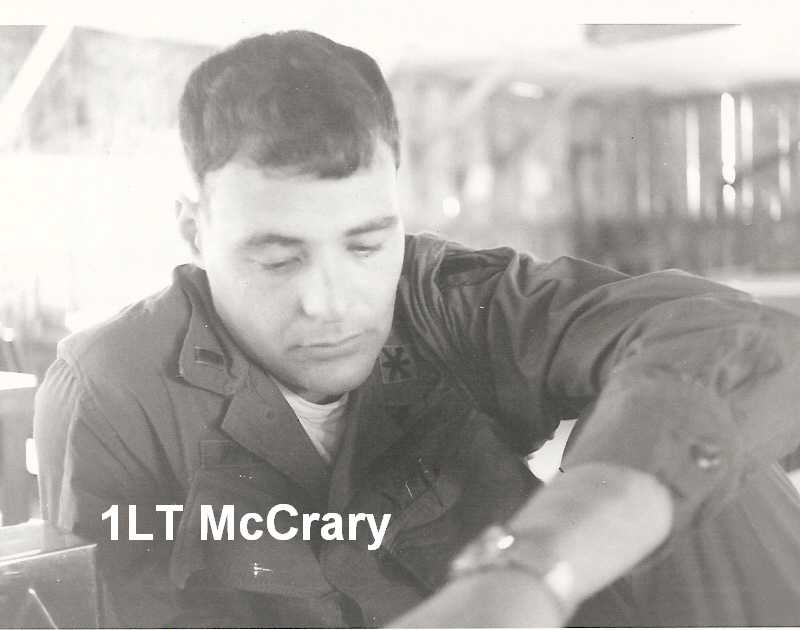 All were outstanding leaders and inspired the other pilots, most of whom were just one year or so out of high school, and not yet 21 years of age. Names like Moys, Burton, Cooney, Magno, Doersam, McDaniel, Pearson, Dodge, Murphy, Miller, Messinger, Hall, Marshall, Collins, O'Sullivan, Young, Wallace, Fife, Fielding, Garber, Holcombe, Hathaway, Lind, Baker, and Banek come to mind when I think of the Sharks. And these were by no means everyone. The flying skills and professionalism displayed by these young men was amazing. A real tribute to the American youth of that generation. A special tribute must be given the crew chiefs and door gunners on the Sharks. These guys were amazing. They flew as the waist gunners on all missions and worked their butts off well into the night getting the aircraft ready for the next day's missions. All were outstanding leaders and inspired the other pilots, most of whom were just one year or so out of high school, and not yet 21 years of age. Names like Moys, Burton, Cooney, Magno, Doersam, McDaniel, Pearson, Dodge, Murphy, Miller, Messinger, Hall, Marshall, Collins, O'Sullivan, Young, Wallace, Fife, Fielding, Garber, Holcombe, Hathaway, Lind, Baker, and Banek come to mind when I think of the Sharks. And these were by no means everyone. The flying skills and professionalism displayed by these young men was amazing. A real tribute to the American youth of that generation. A special tribute must be given the crew chiefs and door gunners on the Sharks. These guys were amazing. They flew as the waist gunners on all missions and worked their butts off well into the night getting the aircraft ready for the next day's missions.
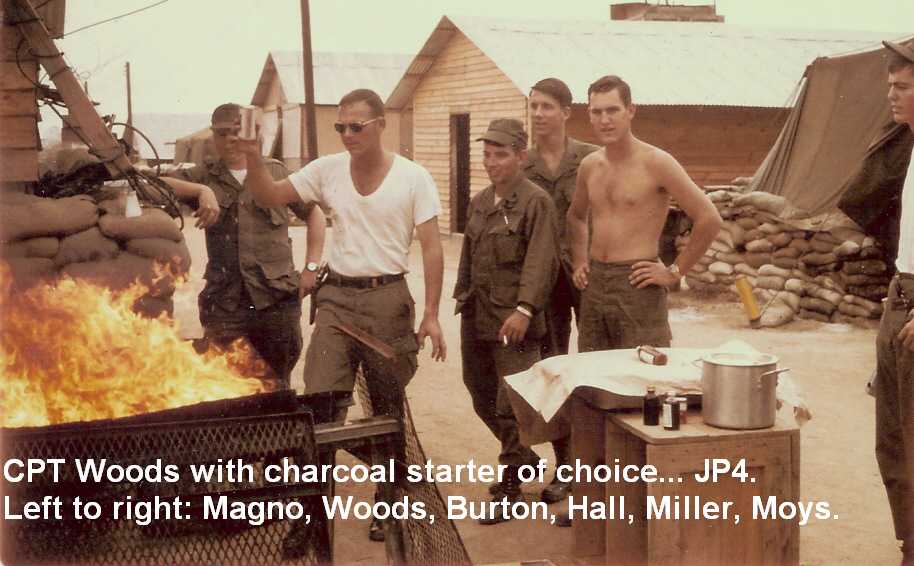
It must be said that the Dolphin pilots and crews were no less skilled or capable than the Sharks. In fact, all Shark pilots had to prove themselves as AC's in the slicks before becoming a Shark. Dolphin pilots often encountered more dangerous situations than the gunship pilots, if for no other reason, than the fact that Charlie didn't hesitate to fire on them. The crew chiefs and door gunners played a pivotal role in the Dolphin operations as far as firepower went, as they were the weapons handlers in addition to overseeing the on-loads, off-loads, etc. Deeds of valor and demonstrated flying skills accomplished by the slick crews which would under normal conditions, be considered heroic and extraordinary, became the norm and even routine. Many feats worthy of awards were never even reported. These crews never received the recognition that they truly deserved.
By April '68, all the D model slicks that were in the company when I arrived in September, with the exception of one, had either been destroyed by enemy action, or crashed. As this attrition occurred, new H models were issued. The single D model left was referred to by all, as "Old Patches." It was polka-dotted with small square patches of bright yellow tape, which covered bullet and scrap metal holes in the fuselage and tail boom. I once counted fifty some such patches! "Old Patches" was finally flown south to be retired, the only ship from the 174th to do so under its own power during that time frame.
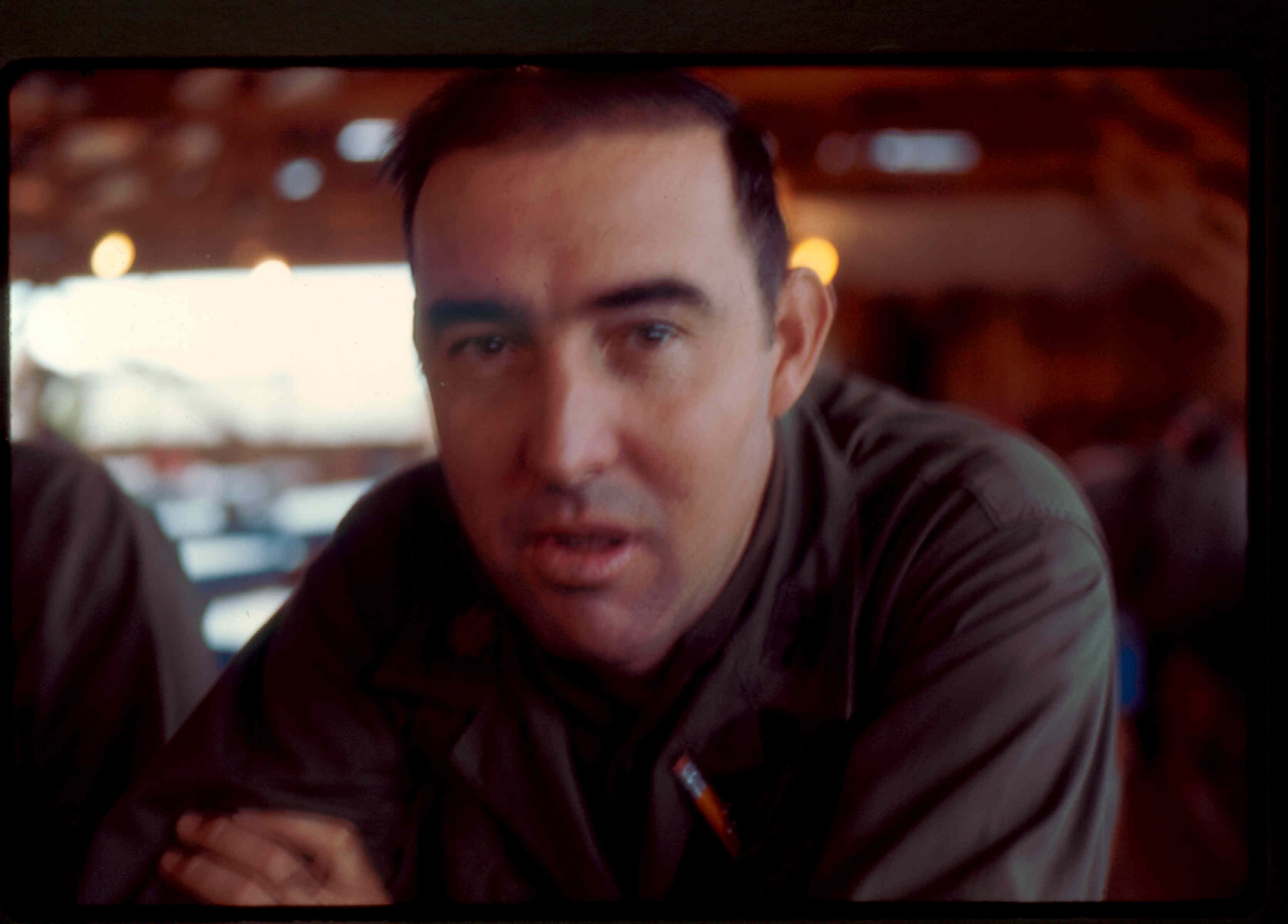
There are many stories to tell, and individuals who deserve acknowledgment, including the Sharks' sinking of the NV trawler loaded with weapons and ammo which attempted to make port just off Duc Pho; the night of the crash of a slick ferrying six pilots returning from Chu Lai and their truly miraculous location and rescue in a driving rainstorm; the tale of the Vietnamese barber with the finely honed razor, who cut hair in the company area daily, and apparently worked as a VC zapper at night. He was found dead on the perimeter wire, loaded down with satchel charges after a failed zapper attack. The shit-burners who meticulously surveyed the company area and provided information to Charlie for his mortar attacks; Tom Wheat's rescue of two grunts from a mine field at night in a heavy rainstorm; good CA's, bad CA's; the building of the O Club and the night Charlie tattooed the newly poured concrete floor with an 82 mm mortar round…. Poker games, crashes, rescues, and heroic deeds and not-so-heroic deeds. But let's save those for another time, hopefully over a cold one with our feet kicked up.
The story of the 174th and Duc Pho cannot be without some comments regarding the infamous and much publicized My Lai incident.
On the morning of March 16, 1968, three or possibly four Dolphin slicks accompanied by four or five slicks from other Americal Division aviation support units, rendezvoused near LZ Dottie to participate in what was commonly known as a "Pickup" CA. The mission that morning, was to move a light infantry company, part of Task Force Barker, approximately 12 miles to the east. Two Shark gunships were assigned to support the mission, and a Dolphin slick was designated as lead aircraft. Two more Sharks returning from an all-night stand-by mission to LZ Baldy joined the flight for the CA insertion. The operation lasted less than 30 minutes and there was little or no resistance in the LZ. All Dolphin aircraft departed immediately after completing the CA, to accomplish their other assigned missions for the day. The Shark gunship team reported engaging three or possibly four VC with weapons, attempting to escape from the area. It would later be revealed that these individuals might have been the only VC combatant casualties at My Lai that morning. Little, if any, further comment or discussion resulted from this seemingly routine mission, and March 16 passed into obscurity like any other day of the war.
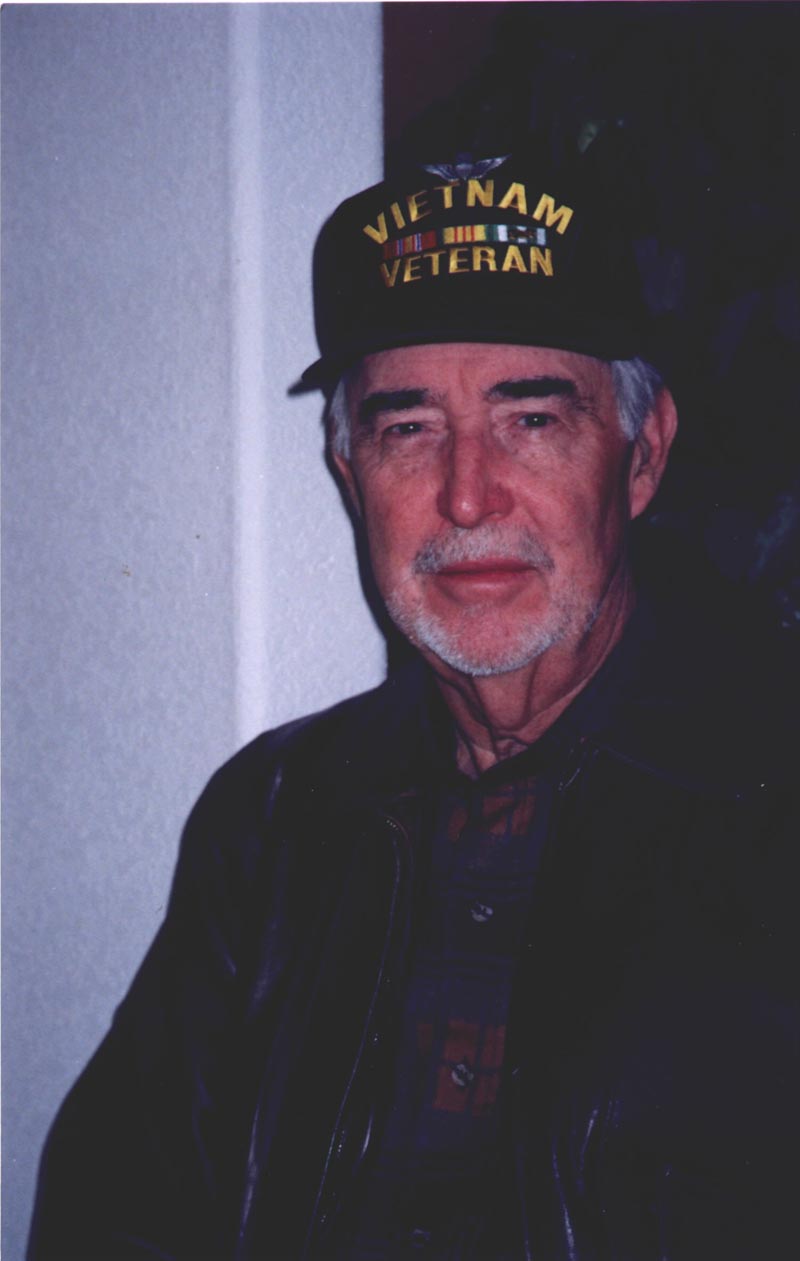 Early one fall morning in 1969, I was sitting at my desk in Crissy AAF operations at the Presidio in San Francisco, sipping coffee and looking out the window as the sunrise reflected off the Golden Gate Bridge. The phone rang, it was a colonel from the IG's office in Washington D.C. Had I ever heard of the term "Pinkvillle?" Did I know anything about a village called My Lai? This phone call kicked off almost three years of anxiety, frustration, anger, and sometimes, despair, in my life. Some other individuals who were assigned to the 174th on March 16, may have had similar experiences. A court order prohibited contact or communication with other individuals concerned, during the investigations.
Early one fall morning in 1969, I was sitting at my desk in Crissy AAF operations at the Presidio in San Francisco, sipping coffee and looking out the window as the sunrise reflected off the Golden Gate Bridge. The phone rang, it was a colonel from the IG's office in Washington D.C. Had I ever heard of the term "Pinkvillle?" Did I know anything about a village called My Lai? This phone call kicked off almost three years of anxiety, frustration, anger, and sometimes, despair, in my life. Some other individuals who were assigned to the 174th on March 16, may have had similar experiences. A court order prohibited contact or communication with other individuals concerned, during the investigations.
As the My Lai investigation developed, it became very clear to me that the infantry commanders were attempting to lay much of the blame for the My Lai casualties onto the Shark gunships and possibly, the artillery that had prepped the LZ prior to the choppers' arrival. I was confident that this was not the case, and spent many hours testifying before the IG, the Peers Board, and the House Armed Services Special Committee, defending my position. I could never tell if I was believed or not. General Peers was the worst, with his arrogant and sarcastic interrogation. Congressman Hebert, was a close runner-up. Finally, it became clear that the gunships were not the culprits and that the blame was being laid at the feet of the real perpetrators.
However, that was not the end of my involvement with the affair. I was now faced with the task of refuting a statement by Colonel Oran Henderson, 11th Brigade commander, that part of his investigation into the My Lai matter was his interrogation of myself and other pilots in the 174th about the incident. I remembered no such interrogation by Col. Henderson and was positive he was mistaken. This conflict resulted in several more trips to Washington, two from as far away as Taiwan, to testify at hearings, and the eventual court martial of Henderson.
During this entire period, my promotion to lieutenant colonel was frozen. However, after it was all resolved, I received the promotion with retroactive DOR, plus back pay. Needless to say, I was much relieved and felt the 174th had been vindicated
That about covers the highlights of my year with the 174th in Viet Nam. I feel honored to have served with one of the best, if not THE best assault helicopter company that flew in Nam. I also feel very lucky to have returned home in one piece. I will never forget all the fine young men I encountered. A class group of true heroes.
If any former members of the 174th have occasion to be in Paso Robles, California, give me a call and let's relive a little of the nostalgia over a cool one.
Glen D. Gibson
Dolphin 6, 1967-68
1032 Putter Ave.
Paso Robles, CA 93446
Ph. 805-238-2818
glenandjoy@aol.com
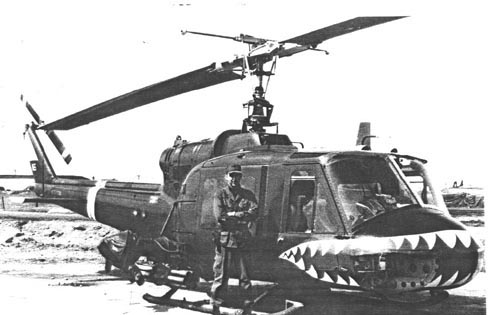
|
![]() Return to top of: 1967 Photos page.
Return to top of: 1967 Photos page.![]() Return to top of: 1968 Photos page.
Return to top of: 1968 Photos page.![]() Return to top of: Home Page.
Return to top of: Home Page.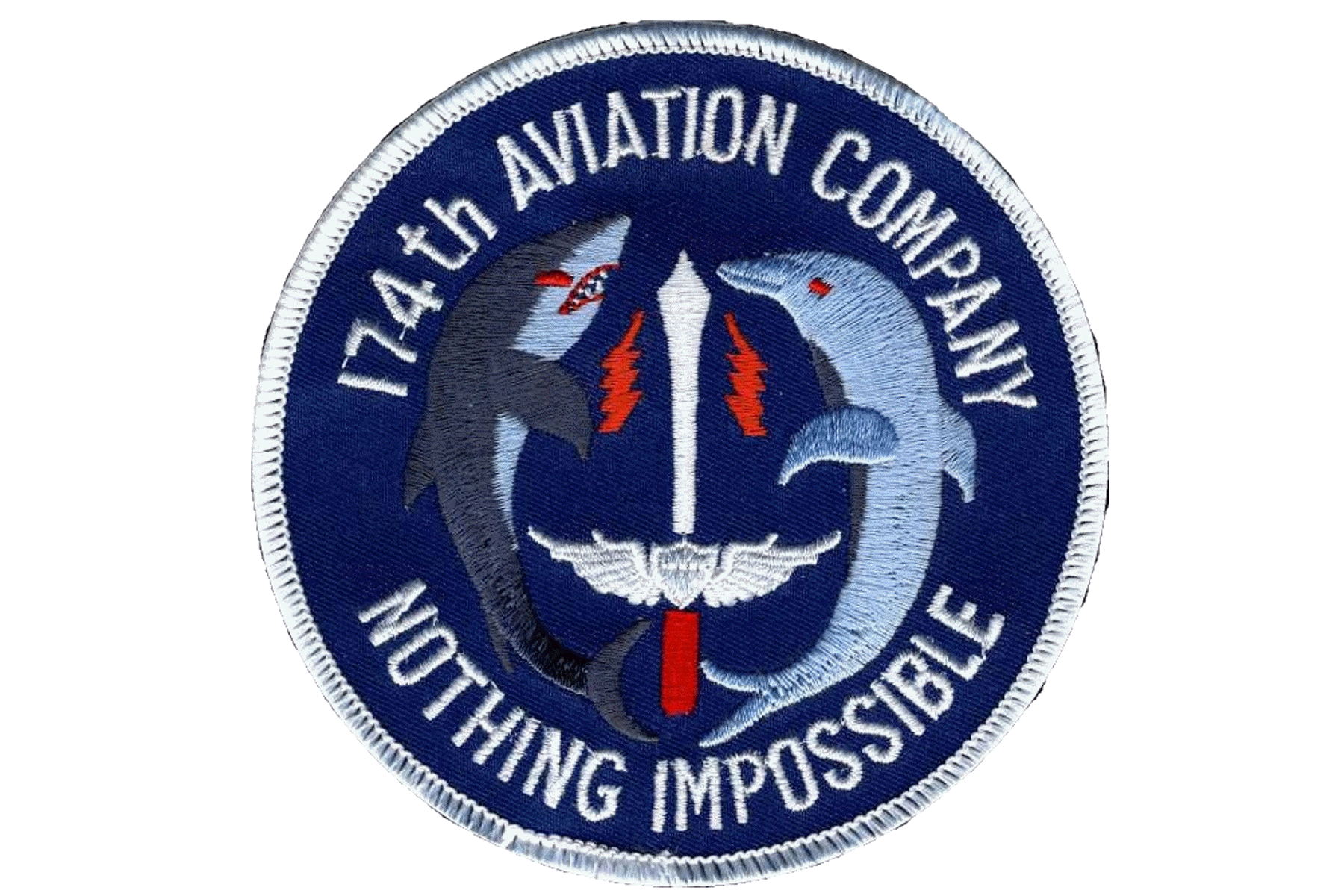
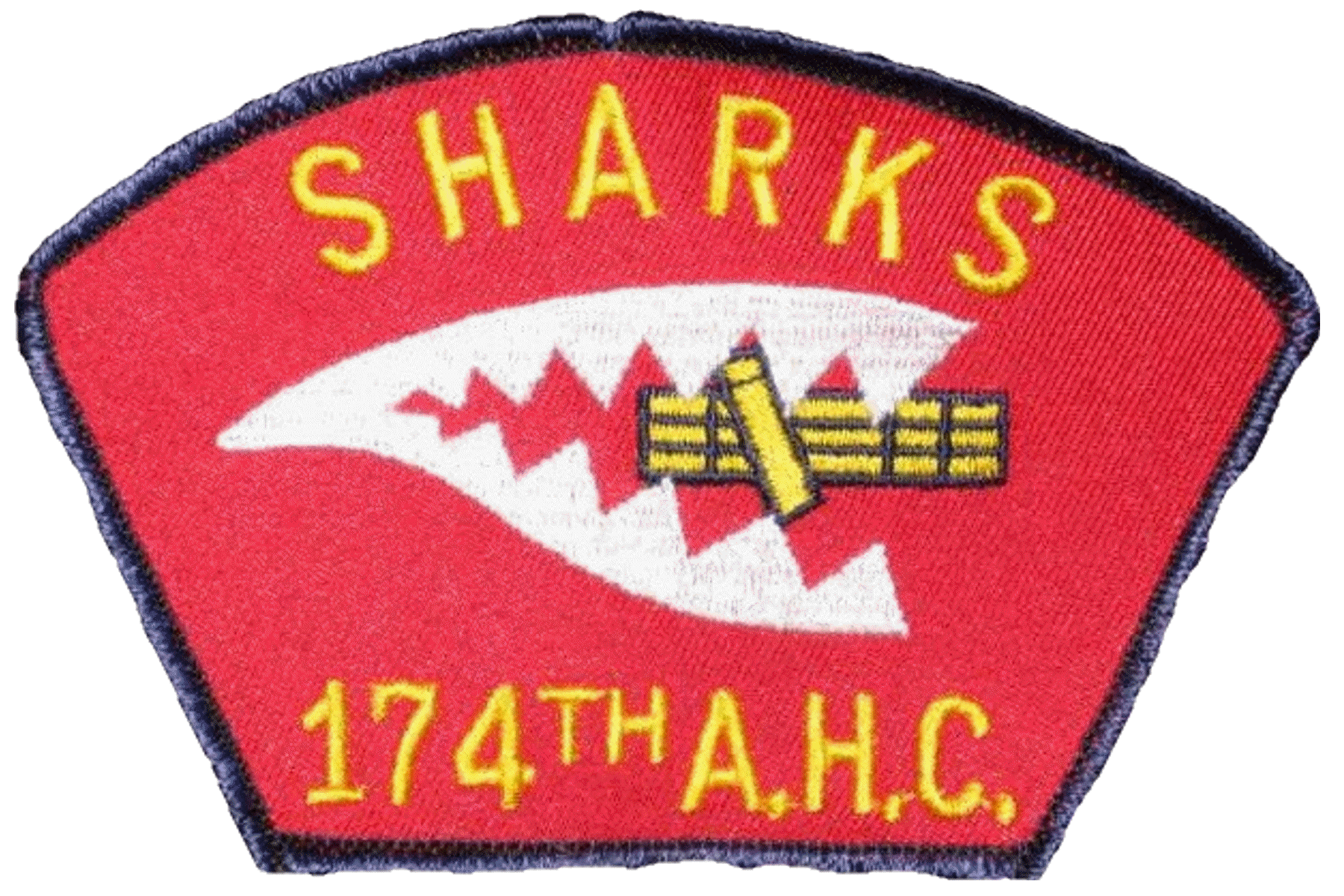
![]() Return to top of: 1967 Photos page.
Return to top of: 1967 Photos page.![]() Return to top of: 1968 Photos page.
Return to top of: 1968 Photos page.![]() Return to top of: Home Page.
Return to top of: Home Page.